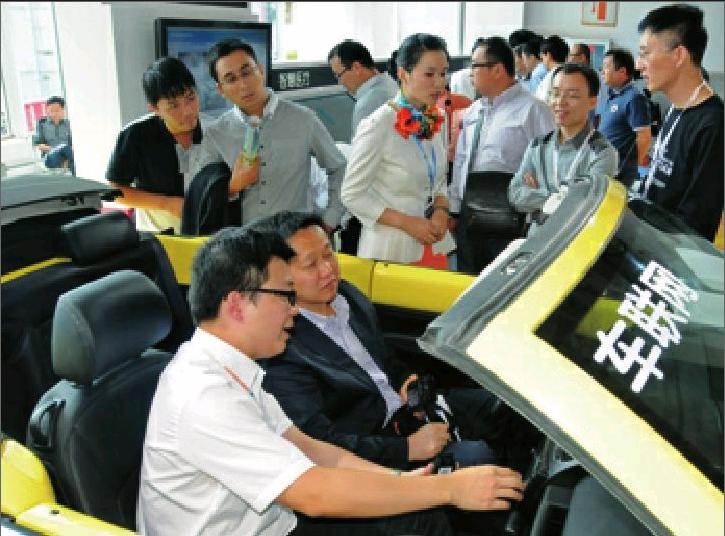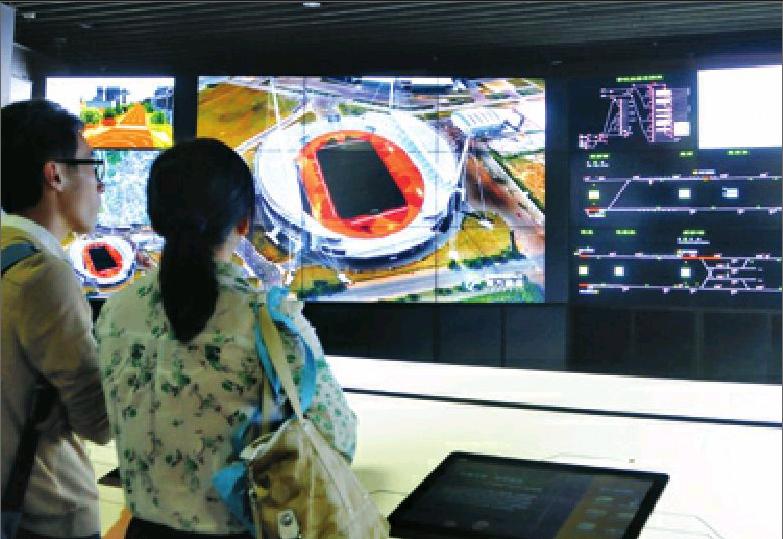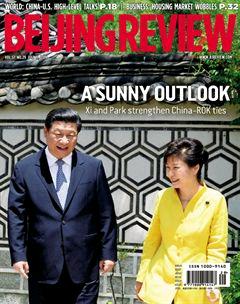Smarter City,Easier life
By+Tang+Yuankai


Imagine the following: texting an order into cellphone on your way home from work, your windows open to let fresh air into your apartment; you can also remotely control your air conditioner, fridge and Tv set from anywhere. you can check the news while at dinner by activating your table, which is also a giant screen. you can contact a doctor to discuss your symptoms instead of having to travel across town to a hospital. Doctors from other cities can also contribute to your diagnosis and treatment if needed.
What may seem like the distant future is becoming a reality in Guangfucheng, a community in Kunming, capital city of Chinas southwest yunnan Province. Though not yet complete, the commercial properties in the community will be handed over to their owners in August. Cloud computing and big data will be put into use at this mega-community with its own office buildings, shopping mall, residential area, parks and schools. It is widely regarded as the first “smart city” project in China.
Featuring the next generation of IT technologies, smart cities are designed to integrate all their existing resources and maximize their value so that urban residents can live a more efficient, convenient and environmentally friendly life.
The development of smart city projects in China has been mainly driven by increasingly open access to information, the integration of different technologies and ongoing changes in project management. Another important driving force is the rapid urbanization China is experiencing. Since China launched its reform and opening-up policy in 1978, Chinas urbanization rate has been twice the global average. Half of Chinas total population lived in towns and cities in 2011, finally meeting the world average. Now 700 million Chinese people are urban residents. The accelerated urbanization has also caused problems such as environmental degradation, traffic jams and shortage of public services. Smart city projects have been proposed as a possible solution.
Almost all large and medium-sized cities in China are either developing or planning their own smart city projects. The plan for Chinas new urbanization (2014-20) issued by the State Council in March specifically requires local governments to promote the smart city campaign.
Incomplete statistics show that the total government investment into smart city projects in China has reached 100 million yuan ($16.1 million). Beijing-based Guodu Securities predicts that the figure will rise to 500 billion yuan ($80.6 billion) by the end of 2015, which would in turn support new industries with total investments worth 2 trillion yuan ($322.6 billion). A list of projects supported by the Central Governments funds for the development of the “Internet of Things,” a core technology underlying the smart city concept, was publicized earlier this year. The government has earmarked a total of 1.5 billion yuan ($241.9 million) to support such projects. Internet of Things related industries saw revenue grew by 36.9 percent to 500 billion yuan ($80.6 billion) in 2013, a figure that is expected to reach 700 billion yuan ($112.9 billion) in 2015.endprint
Building smart cities can also lead to improved public services and more sustainable development. According to a recent report from the market research company MarketsandMarkets, global investment in smart city infrastructure will total $3 trillion to $4 trillion over the next two decades. The same report said that the global smart city market was$526.3 billion in 2011 and is expected to double in the year 2016.
While the government is promoting this concept, a large group of multinationals have also shown their enthusiasm in building up smart city infrastructure.
Cisco, who celebrated their 20th anniversary of entering the Chinese market on June 25, announced the establishment of its Chinese headquarters in Hangzhou, east Chinas Zhejiang Province, as a part of the companys plan to participate in developing the countrys smart-connected industries.
The company will expand into areas including healthcare, education, information and transportation in Hangzhou as part of the citys plan to establish a smart-connected platform for the general public.
Guangfucheng in Kunming is backed up in technology by IBM and Huawei Technologies.
“We have used our technologies to build a nervous system for the community,” said Hao Guoqiang, who heads the Enterprise Business Department of Huaweis branch in yunnan. Hao said that the company is determined to make the community into a model smart city the rest of the country can emulate.
IBM invented the idea of smart cities in 2008 and made it a reality for the first time in Dubuque, Iowa, in September 2009. “We have provided the Guangfucheng project with technological infrastructure, a cloud computing center and other state-of-theart technologies, which will benefit property owners, shop owners and residents,” said Liu Wenchao, a senior executive with IBM Global Technology Services.
Pilot programs
Starting from last November, bus passengers in Fuyang, the most populous city of east Chinas Anhui Province, can check how long they have to wait for their buses using their cellphones. Telecom giant China Mobiles local branch has cooperated with Fuyangs bus company to embed every bus with a network-enabled GPS module so that local residents can check the real-time positions of all buses using a free application for smartphones and other devices.
The application is planning on adding functionality to enable its users to pay their water and electricity bills, review their traffic violations, purchase cinema tickets and reserve a doctors appointment.endprint
Fuyang became a city for experimental smart city programs designated by the Ministry of Housing and Urban-Rural Development(MOHURD) last August. Subordinate programs include the installation of traffic control and intelligent bus command centers.
“Building smart cities is integral for Chinas goal of building a society that is moderately prosperous in all aspects,” said Lu yongxiang, former President of the Chinese Academy of Sciences. He said that in smart cities, people would be able to enjoy more opportunities to create a better future and pursue their personal dreams, which will in turn provide these cities with inexhaustible drive for development.
Now the MOHURD has designated a total of 193 locations to undertake pilot programs for smart technology, including cities, counties and towns.
Ma Hong, an official with the MOHURD, said that the ministry is compiling a national standard for smart city evaluation. “As the first standard of its kind in China, it will regulate the construction and management of smart cities, unify the models and indexes for their construction and management and serve as the only criterion for measuring their construction progress, levels and efficiency,” she said. The standard is expected to be completed by the end of this year and subsequently filed for review.
Despite the lack of a standard, cities with trial smart city programs have reached a consensus that efforts should not only be focused on the application of intelligent technologies, but also the participation of ordinary people and the capacity of sustainable innovation.
“The pilot programs in Beijing prioritize satisfying the needs of city dwellers and urban development,” noted Tong Tengfei, Deputy Director of the Beijing Municipal Commission of Economy and Information Technology.
The Beijing Municipal Government has designed an application for mobile devices—Beijing Serving you—to issue notices from government departments that concern the citys residents, like emergency warnings, traffic information and weather forecasts. Another future project for the government in Beijing is to combine the different household cards used to pay water, electricity, natural gas and heating bills into one card to make residents lives easier. All the taxis and buses in Beijing have been equipped with GPS modules so that they can be monitored and given directions to avoid severe traffic jams.
Shanghai has also applied smart city tech-nologies to its traffic management. All the traffic flows on highways and intra-city roads have been monitored and the information is conveniently made available on the Internet, digital signs and cellphones. The city is also building a comprehensive platform to process all kinds of traffic information. “It will be the largest traffic information-processing system in the world,”said yang Tao, an engineer with Shanghai Traffic Information Center.endprint
Shanghai has also built a database to allow all city-level hospitals to share the clinical information of patients. Liu Jian, Deputy Director of Shanghai Municipal Commission of Economy and Informatization, said that the electronic health records for individuals established during the process will also assist decision making on healthcare policies.
Upgrades needed
With more objects becoming embedded with sensors and gaining the ability to communicate with other devices, the resulting information networks will undoubtedly result in the creation of new business models, improved business processes, and reduced costs and risks. The widespread adoption of such technology relies on massive increases in storage and computing power, however. Some of this extra power is available via cloud computing, which makes number crunching possible on a larger scale and at lower costs.
Beijing is building a world-class R&D center for cloud computing in yizhuang in the citys southeast suburb.
The technological level of sensors has a significant bearing on the success of monitoring and collecting various kinds of data needed by city administrators. According to the Ministry of Industry and Information Technology (MIIT), the Chinese sensor market scale rose from 15.43 billion yuan ($2.5 billion) in 2004 to 130 billion yuan ($21 billion) in 2013. However, more than 95 percent of sensors in China are imported. At a conference in June, Guo yuansheng, Deputy Chief Engineer of the Electronic Components Industry Development Research Center under the MIIT, said that although 26 out of Chinas 31 provinces, municipalities and autonomous regions have completed their development plans for their Internet of Things, most dont have the industrial or technological base, nor the core technologies and application capacity needed. The MIIT issued a list of key
tasks for the development of the Internet of Things on June 17, which stressed making breakthroughs in key technologies, including the research and development of sensors, chips, information transmission and processing technologies. The document also singled out the overall planning, promoting industrial standards, supporting leading enterprises and nurturing the development of related industries.
At a forum on smart cities in May, Wen Ku, head of the Department of Telecommunication Development of the MIIT, said that in the latest edition of Global Information Technology Report, China ranked 62nd in Networked Readiness Index, which doesnt match Chinas overall economic scale or the publics expectations toward building smart cities. He said that it means that the outlook for the development of smart cities in China is not as optimistic as most people think but there is still space for explosive growth. endprint
endprint

